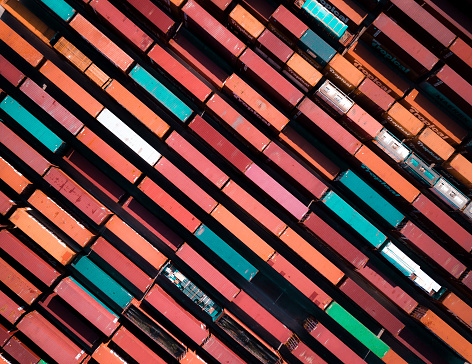In this article, Marina Comninos explains how the electronic bill of lading (eBL) is key to transforming international trade. Marina Comninos is the Co-Head for ICE Digital Trade, formerly known as essDOCS, and a member of the ICC Commercial Law and Practice Commission.
在本文中,Marina Comninos 解釋了電子提單 (eBL) 如何成為改變國際貿易的關鍵。Marina Comninos 是 ICE Digital Trade(前身為 essDOCS)的聯合負責人,也是 ICC 商法和實踐委員會的成員。
The views and opinions expressed in this article are those of our authors and do not necessarily reflect the official policy or position of the ICC Academy or ICC.
本文中表達的觀點和意見是我們作者的觀點和意見,並不一定反映 ICC 學院或 ICC 的官方政策或立場。
Electronic bills of lading (eBLs) are here to stay, at last. BIMCO’s “25 by 25” campaign surpassed its initial target within its first year. The campaign, launched in 2023, commits major shippers in the bulk sector to use eBLs for at least 25% of their annual seaborne trade volume for one commodity by 2025. The initial four participating shippers, BHP, Rio Tinto, Vale and Anglo American, who together account for approximately 75%+ of global iron ore trade, exceeded this target in their iron ore trade by mid-2024. And their digital penetration rate in metals and minerals is constantly rising.
電子提單 (eBL) 終於要繼續存在了。BIMCO 的“25 by 25”活動在第一年就超過了最初的目標。該活動於 2023 年啟動,承諾到 2025 年,散貨行業的主要託運人將電子提單用於其一種商品的年度海運貿易量的至少 25%。最初參與的四家託運人,必和必拓、力拓、淡水河谷和英美資源集團,合計佔全球鐵礦石貿易量的 75%+,到 2024 年年中,他們的鐵礦石貿易量超過了這一目標。他們在金屬和礦物領域的數位滲透率不斷上升。
This paper examines why bills of lading (BLs) are so vital in international trade and how digitizing them is transforming trade.
本文探討了提單 (BL) 在國際貿易中為何如此重要,以及提單的數位化如何改變貿易。
The importance of the bill of lading in international trade
提單在國際貿易中的重要性
BLs are essential in international trade, performing three key functions:
BL 在國際貿易中至關重要,它執行三個關鍵功能:
- Receipt: The BL, which is issued by the carrier, serves as proof that the cargo has been loaded onto the vessel, documenting the quantity and condition of the goods at the time of shipment. As a rule, a subsequent holder of the BL can rely on statements made in the BL and, should the actual goods not match their description in the BL, the receiver can sue the carrier for damages.
收據:BL 由承運人簽發,作為貨物已裝載到船上的證明,記錄了貨物裝運時的數量和狀況。通常,提單的後續持有人可以依賴提單中的陳述,如果實際貨物與其在提單中的描述不符,收貨人可以起訴承運人要求賠償。 - Contract of Carriage: The BL evidences the contract of carriage. Normally, the terms on which the shipper will be entitled to use the carrier’s ship are set out in the charterparty between the carrier and the shipper. However, in the hands of a buyer to whom the BL has been transferred by the seller, the terms of the BL will prevail over the terms of the charterparty.
運輸合同: 提單是運輸合同的證明。通常,託運人有權使用承運人船舶的條款在承運人和託運人之間的租船合同中規定。然而,如果賣方已將提單轉讓給買方,提單的條款將優先於租船合同的條款。 - Document of title: The rightful holder of a bill of lading can demand delivery of the goods by surrendering the BL back to the carrier. This is critical in commodity trading: buyers are willing to pay for goods which are still in transit in return for physical possession of the BL, as that gives them the right to demand delivery of those goods at the discharge port or resell the goods to another buyer.
擁有權檔: 提單的合法持有人可以通過將提單交還給承運人來要求交付貨物。這在商品交易中至關重要:買方願意為仍在運輸途中的貨物付款,以換取實際擁有提單,因為這使他們有權要求在卸貨港交付這些貨物或將貨物轉售給其他買方。
Despite their critical importance and the vulnerabilities associated with their paper format—such as susceptibility to fraud and significant inefficiencies – BLs have largely remained paper-based. This represents a paradox within the context of contemporary advancements in digital technology, artificial intelligence, natural language processing, and big data. The justifications often cited by the industry for the lack of digitization include legal uncertainties, the international nature of trade, a perception that paper-based systems function adequately, and a lack of demand for eBL solutions from clients and partners.
儘管提單至關重要,並且存在與紙質格式相關的漏洞(例如易受欺詐和嚴重效率低下的影響),但提單在很大程度上仍然基於紙張。這在數字技術、人工智慧、自然語言處理和大數據的當代進步背景下是一個悖論。該行業經常引用的缺乏數位化的理由包括法律不確定性、貿易的國際化性質、認為紙質系統能夠充分運行以及客戶和合作夥伴對 eBL 解決方案缺乏需求。
In this article, we will look at each of these challenges (myths) and seek to debunk some of the noise that prevents the industry from adopting eBLs and to focus on how we can accelerate this transition from analog to digital by overcoming the remaining challenges.
在本文中,我們將研究這些挑戰(神話)中的每一個,並試圖揭穿阻礙該行業採用 eBL 的一些噪音,並專注於我們如何通過克服剩餘的挑戰來加速從類比到數位的過渡。

Certificate in Digital Trade Strategy (CDTS)
數位貿易策略憑證 (CDTS)
瞭解數位貿易的關鍵方面,從基本的巨集觀角度到微觀層面的應用。該計劃已於 2024 年 9 月更新。
The evolution of the bill of lading: From analog to digital
提單的演變:從類比到數位
The International Chamber of Commerce estimates that 4 billion documents move through the global trade system on any given day.
國際商會估計,每天有 40 億份檔通過全球貿易系統。
Read: Digital Trade 101 – What you need to know
閱讀: 數字貿易 101 – 您需要了解的內容
McKinsey estimates that digitising bills of lading could save $6.5 billion in direct costs and enable $40 billion in global trade. Surely that is incentive enough for the industry and other stakeholders to be laser focused on facilitating the transition, even if it is complex? That has not, historically, been the case though.
麥肯錫估計,數位化提單可以節省 65 億美元的直接成本,並實現 400 億美元的全球貿易 。這肯定足以激勵行業和其他利益相關者專注於促進轉型,即使它很複雜?不過,從歷史上看,情況並非如此。
Technological challenge 技術挑戰
Attempts at trade digitization stretch back to the 1980s: Starting with Intertanko and Chase Manhattan’s brief SeaDocs initiative in the mid-1980s to the EU-supported EDIBOL project and Bill of Lading Europe (Bolero) in the 1990s, and Shell and BP’s ongoing collaborations with Solidocs until the early 2000s.
貿易數位化的嘗試可以追溯到 1980 年代:從 1980 年代中期 Intertanko 和 Chase Manhattan 的簡短 SeaDocs 計劃開始,到 1990 年代歐盟支援的 EDIBOL 專案和歐洲提單 (Bolero),以及殼牌和 BP 與 Solidocs 的持續合作,直到 2000 年代初。
By the 2000s, technological breakthroughs in the form of easily accessible and cost-effective SaaS solutions, and trust in the power of digital driven by the uptake in online banking and other asset registries, enabled adoption by the innovators and early adopters. The first operational rollout of eBLs was in 2010, when various European and Americas energy market participants started operational adoption of ICE Digital Trade’s eBL Solution. The metals and agricultural markets followed around 2015 and leading container lines committed last year to fully transition to eBLs by 2030.
到 2000 年代,易於訪問且具有成本效益的 SaaS 解決方案形式的技術突破,以及對網上銀行和其他資產登記所驅動的數位力量的信任,使創新者和早期採用者能夠採用。eBL 的首次運營推出是在 2010 年,當時歐洲和美洲的能源市場參與者開始在運營中採用 ICE Digital Trade 的 eBL 解決方案。 金屬和農產品市場緊隨其後,2015 年左右,領先的集裝箱航運公司去年承諾到 2030 年完全過渡到電子提單 。
Legal challenge 法律挑戰
However, progress was slow, and a key reason cited by the industry to explain the pace of adoption was legal uncertainty. Historically, national laws did not recognise eBLs as the legal equivalent of paper bills, so eBL providers have developed contractual frameworks which ensure that their eBLS are legally and functionally equivalent to paper bills.
然而,進展緩慢,該行業引用的解釋採用速度的一個關鍵原因是法律的不確定性。從歷史上看,國家法律不承認 eBL 在法律上等同於紙質帳單,因此 eBL 供應商制定了合同框架,以確保其 eBLS 在法律和功能上等同於紙質帳單。
While these contractual frameworks have proven valuable and some have received broad acceptance, a legislative landscape enabling trade digitisation was bound to follow. Industry pressure, and the impact of COVID-19 on international trade, meant that a decade later some progress was finally made in modernising eBL legislation. The foundations were set in 2017, when UNCITRAL published the Model Law on Electronic Transferable Records (MLETR).
雖然這些合同框架已被證明是有價值的,並且有些框架已經得到廣泛接受,但支援貿易數位化的立法環境必然會隨之而來。行業壓力以及 COVID-19 對國際貿易的影響意味著十年後,電子提單立法的現代化終於取得了一些進展。2017 年,貿易法委員會發佈了《 電子可轉讓記錄示範法》(MLETR), 奠定了基礎。
Read: MLETR – An overview of UNCITRAL’s Model Law on Electronic Transferable Documents
閱讀:MLETR – 貿易法委員會《電子可轉讓文件示範法》概述
To date, of the key maritime nations, the US, Singapore and the UK have changed their laws so that eBLs now have the same legal effect as their paper counterparts. France, Germany and the Netherlands are soon to follow, and the APEC have publicly declared that they will adopt legislation recognising eBLs. These laws require an eBL solution to be ‘reliable’ and that is a definition the industry has been grappling with. In October 2024, the ICC Digital Standards Initiative released a beta version of a self-assessment framework, which has now been finalised and released.
迄今為止,在主要海運國家中,美國、新加坡和英國已經修改了法律,使電子提單現在與紙質提單具有相同的法律效力。法國、德國和荷蘭很快緊隨其後,APEC 已公開宣佈將通過承認電子提單的立法。這些法律要求 eBL 解決方案“可靠”,這是該行業一直在努力解決的定義。2024 年 10 月,ICC 數位標準倡議組織發佈了自我評估框架的測試版,該框架現已最終確定併發佈。
Cyber challenge 網路挑戰
There has also, justifiably, been a lot of focus on ensuring that eBLs are secure: they are, after all, the ‘key to the warehouse’, entitling their holder to take delivery of cargos worth millions of dollars. There is some irony in this, as paper bills of lading set the bar on security quite low: the industry relies on an illegible handwritten squiggle at the bottom and back of a piece of paper which is transported by courier from one office to another. A digital solution, which can identify and control access, maintain logs and automate what otherwise requires planes, trains and automobiles, will always win. And the industry does a lot more than just improve on paper security: robust eBL platforms can provide a highly secure, auditable, transparent means of rewiring and digitalising post trade operations.
有理由的是,人們也非常重視確保電子提單的安全:畢竟,它們是“倉庫的鑰匙”,持有人有權接收價值數百萬美元的貨物。這有點諷刺意味,因為紙質提單將安全門檻定得相當低:該行業依賴於一張紙的底部和背面難以辨認的手寫波浪線,該波浪線由快遞員從一個辦公室運送到另一個辦公室。能夠識別和控制訪問、維護日誌並自動化原本需要飛機、火車和汽車的工作的數位解決方案將永遠獲勝。該行業所做的不僅僅是提高紙張安全性:強大的 eBL 平臺可以提供高度安全、可審計、透明的方式來重新佈線和數位化交易後作。
‘Sitting on the fence’ challenge
“坐在圍欄上”挑戰
It is surprising how entrenched the ‘it works why change it’ argument has been. People have found multiple excuses to stay on the fence, not taking the leap to digital, even in the face of overwhelming and obvious digitisation benefits. The fact that every other industry is already digital does not shake the faith that shipping and trade are different, somehow ‘justifiably’ more conservative.
令人驚訝的是,“ 它有效,為什麼要改變它 ”的論點如此根深蒂固。人們找到了多種藉口持觀望態度,即使面對壓倒性和明顯的數字化優勢,也不敢邁向數位化。其他所有行業都已經數位化的事實並不能動搖航運和貿易不同的信念,在某種程度上“ 有理由” 更加保守。
However, , by the mid-2020s, the industry has multiple technical solutions to digitise trade, is satisfied that the resilience and security of these digital trade solutions can be ensured and is on track to overcome the key, legal hurdle. It seems that the industry has stopped looking for excuses and the late majority is instead looking for paths to digitisation. There is finally broad recognition of the numerous benefits of digitising: the convergence of the physical, financial, and document chains enables banks and corporates to mitigate risks, automate processes, enhance working capital management, and lower operational costs.
然而,到 2020 年代中期,該行業擁有多種技術解決方案來實現貿易數位化,對可以確保這些數位貿易解決方案的彈性和安全性感到滿意,並有望克服關鍵的法律障礙。該行業似乎已經不再尋找藉口,而大多數後代都在尋找數位化的途徑。數位化的眾多好處終於得到了廣泛的認可:物理、財務和文檔鏈的融合使銀行和企業能夠降低風險、自動化流程、加強營運資金管理並降低運營成本。
The trick now is not to lose momentum: we need to accelerate to avoid burnout by those in the industry who are digitising.
現在的訣竅是不要失去動力:我們需要加速,以避免行業內數位化的人倦怠。

Global Trade Certificate
全球貿易證書
ICC 的入門級在線貿易融資證書。
What challenges remain to fully and finally digitise trade?
要實現貿易的全面數位化,還有哪些挑戰?
Reaching critical mass, where trade is predominantly digital, requires the industry, with the support and expertise of solution providers, to address the two key remaining hurdles:
在貿易以數位化為主的地區,要達到臨界規模,該行業需要解決方案供應商的支持和專業知識,以解決剩下的兩個關鍵障礙:
- Interoperability: Digital trade requires participation across the supply chain, and the benefits increase with the size of the network. A prerequisite to mass adoption is therefore the ability of eBL solutions to interoperate: members of the international trade community must be free to choose their preferred eBL platform(s), and be able to interact with counterparties who have not made the same choice. So, what is the industry doing to facilitate this?
互作性 : 數字貿易需要整個供應鏈的參與,並且好處會隨著網路規模的增加而增加。因此,大規模採用 eBL 解決方案的先決條件是 eBL 解決方案的互作性: 國際貿易界的 mothers 必須能夠自由選擇他們喜歡的 eBL 平臺,並能夠與沒有做出相同選擇的交易對手進行互動。那麼,該行業正在採取哪些措施來促進這一點呢?- Broad adoption of laws recognizing eBLs as equivalent to their paper counterparts is key to this. Stakeholders need to keep lobbying governments to enact MLETR, or a piece of legislation influenced by the MLETR.
廣泛採用承認 eBL 等同於紙質 EL 的法律是實現這一目標的關鍵。 利益相關者需要不斷遊說政府頒布 MLETR,或受 MLETR 影響的立法。
- Technical interoperability and data standards requires close collaboration between the relevant stakeholders, and great work has been done by the Digital Container Standards Association (DCSA) and the Future International Trade (FIT) Alliance to enable this.
技術互作性和數據標準需要相關利益相關者之間的密切合作, 數位容器標準協會 (DCSA) 和未來國際貿易 (FIT) 聯盟已經為此做了大量工作。 - Solution providers need to work together to develop interoperable solutions showing successful adoption and scalable use and giving the industry a path forward. A number of projects are in the works so meaningful developments are not far off.
解決方案供應商需要共同努力,開發可互作的解決方案,展示成功採用和可擴展使用,併為行業提供前進的道路。許多專案正在進行中,因此有意義的發展不遠了。
- Broad adoption of laws recognizing eBLs as equivalent to their paper counterparts is key to this. Stakeholders need to keep lobbying governments to enact MLETR, or a piece of legislation influenced by the MLETR.
Read about the FIT Alliance here: Future International Trade Alliance launched
在此處閱讀有關 FIT 聯盟的信息: 未來國際貿易聯盟啟動
Read about the DCSA here: DCSA’s role in the digital transformation of container shipping
在此處閱讀有關 DCSA 的資訊:DCSA 在集裝箱運輸數位化轉型中的作用
- Change Management: If project management is like herding cats, and program management is like herding tigers, then digitizing trade is like herding all the planet’s animals onto Noah’s Ark while it’s still under construction. Digitising trade is a complex project because it requires simultaneous change across three industries, commodity trading plus shipping plus banking. Even within an organization, contracts and process changes must be made across several departments with different priorities and drivers. For corporates, this change management includes trading, finance, execution or operations and freight departments. For banks it will include a review of risk across multiple jurisdictions and regulatory environments. As a result, trade digitisation requires coordinated and simultaneous change management across the supply chain. The tools to address this challenge are well known:
變更管理 :如果專案管理就像放牧貓,專案管理就像放羊老虎,那麼數位化貿易就像在諾亞方舟仍在建設 中的時候把地球上所有的動物都趕上。數字化貿易是一個複雜的專案,因為它需要同時跨三個行業進行變革,即商品貿易加航運加銀行。 即使在一個組織內部, 合同和流程變更必須在具有不同優先順序和驅動因素的多個部門之間進行。 對於企業來說,這種變更管理包括貿易、財務、執行或運營以及貨運部門。 對於銀行來說,它將包括對多個司法管轄區和監管環境的風險審查。因此,貿易數位化需要在整個供應鏈中協調和 同步 地進行變更管理。應對這一挑戰的工具是眾所周知的:- Focus on easy wins to demonstrate that digitizing is possible and to demonstrate value
專注於輕鬆的勝利,以證明數位化是可能的,並展示價值 - Build industry consensus and momentum, as ultimately no company can digitize trade by themselves
建立行業共識和勢頭,因為最終沒有公司可以自行實現貿易數位化 - Digitise in steps to ensure that benefits can be quickly realized as you progress
逐步實現數位化,以確保隨著您的進步而快速實現優勢 - Ensure that you publicly communicate your plans both within your organization and your industry, so others can learn from your work and work with you towards digitization
確保您在組織和行業內公開傳達您的計劃,以便其他人可以從您的工作中學習並與您一起實現數位化 - Publicise the benefits of digitization, to ensure the value proposition can be clearly articulated
宣傳數位化的好處,以確保價值主張可以清晰地表達出來 - Set realistic timelines and provide incentives for digital transformation to your teams and counterparts
為您的團隊和同行設定切合實際的時程表併為數字化轉型提供激勵措施
- Focus on easy wins to demonstrate that digitizing is possible and to demonstrate value
Leading global trade’s digital shift
引領全球貿易的數字化轉型
Trade cannot truly prosper in the 21st century without digitization. The benefits are self-evident, as digitisation will reduce the cost of trade finance, which will boost global trade. Implementation is long overdue, but addressing the remaining hurdles is possible, with deep expertise and a cooperative approach. Strong, decisive leadership is critical to this, and we are seeing the industry take the critical steps needed to deal with the last bastion of paper, and finally to shift the shipping and trading industries from analog to digital.
沒有數位化,貿易就無法在 21 世紀真正繁榮。好處是顯而易見的,因為數位化將降低貿易融資成本,從而促進全球貿易。 實施早就應該實施了,但通過深厚的專業知識和合作方法,解決剩餘的障礙是可能的。強有力、果斷的領導對此至關重要,我們看到該行業採取了必要的關鍵步驟來應對最後的紙張堡壘,並最終將航運和貿易行業從模擬轉變為數位。
A 2024 survey conducted by the International Chamber of Commerce (ICC) and other FIT Alliance co-founders BIMCO, DCSA, FIATA and SWIFT reveals a steady rise in the adoption of eBLs. Read the survey results here.
國際商會 (ICC) 和其他 FIT 聯盟聯合創始人 BIMCO、DCSA、FIATA 和 SWIFT 在 2024 年進行的一項調查顯示,電子提單的採用率穩步上升。 在此處閱讀調查結果 。




